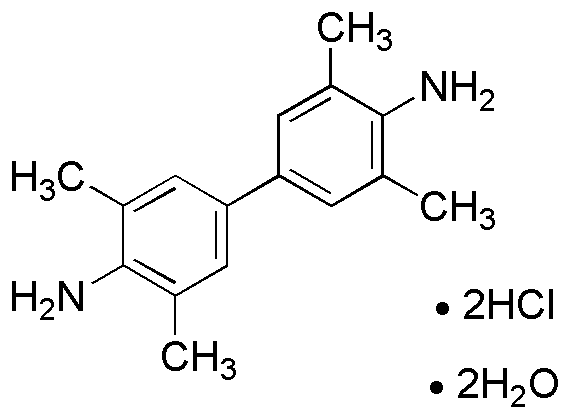3,3',5,5'-Tetramethylbenzidine dihydrochloride dihydrate is widely utilized in research focused on:
- Colorimetric Assays: This compound is a key substrate in enzyme-linked immunosorbent assays (ELISA), providing a color change that indicates the presence of specific antigens or antibodies, making it invaluable in clinical diagnostics.
- Histochemistry: It is commonly used as a chromogen in histological staining, allowing researchers to visualize cellular structures under a microscope, which is essential in pathology and tissue analysis.
- Biochemical Research: The compound serves as a sensitive indicator in various biochemical reactions, helping scientists track enzymatic activity and metabolic processes in cellular studies.
- Environmental Testing: It can be applied in detecting pollutants and toxins in environmental samples, aiding in water quality assessments and ecological studies.
- Pharmaceutical Development: The compound is utilized in drug formulation and testing, particularly in evaluating drug interactions and efficacy through various assay techniques.
General Information
Properties
Safety and Regulations
Applications
3,3',5,5'-Tetramethylbenzidine dihydrochloride dihydrate is widely utilized in research focused on:
- Colorimetric Assays: This compound is a key substrate in enzyme-linked immunosorbent assays (ELISA), providing a color change that indicates the presence of specific antigens or antibodies, making it invaluable in clinical diagnostics.
- Histochemistry: It is commonly used as a chromogen in histological staining, allowing researchers to visualize cellular structures under a microscope, which is essential in pathology and tissue analysis.
- Biochemical Research: The compound serves as a sensitive indicator in various biochemical reactions, helping scientists track enzymatic activity and metabolic processes in cellular studies.
- Environmental Testing: It can be applied in detecting pollutants and toxins in environmental samples, aiding in water quality assessments and ecological studies.
- Pharmaceutical Development: The compound is utilized in drug formulation and testing, particularly in evaluating drug interactions and efficacy through various assay techniques.
Documents
Safety Data Sheets (SDS)
The SDS provides comprehensive safety information on handling, storage, and disposal of the product.
Product Specification (PS)
The PS provides a comprehensive breakdown of the product’s properties, including chemical composition, physical state, purity, and storage requirements. It also details acceptable quality ranges and the product's intended applications.
Certificates of Analysis (COA)
Search for Certificates of Analysis (COA) by entering the products Lot Number. Lot and Batch Numbers can be found on a product’s label following the words ‘Lot’ or ‘Batch’.
Numéro de catalogue
Numéro de lot/série
Certificates Of Origin (COO)
This COO confirms the country where the product was manufactured, and also details the materials and components used in it and whether it is derived from natural, synthetic, or other specific sources. This certificate may be required for customs, trade, and regulatory compliance.
Numéro de catalogue
Numéro de lot/série
Safety Data Sheets (SDS)
The SDS provides comprehensive safety information on handling, storage, and disposal of the product.
DownloadProduct Specification (PS)
The PS provides a comprehensive breakdown of the product’s properties, including chemical composition, physical state, purity, and storage requirements. It also details acceptable quality ranges and the product's intended applications.
DownloadCertificates of Analysis (COA)
Search for Certificates of Analysis (COA) by entering the products Lot Number. Lot and Batch Numbers can be found on a product’s label following the words ‘Lot’ or ‘Batch’.
Numéro de catalogue
Numéro de lot/série
Certificates Of Origin (COO)
This COO confirms the country where the product was manufactured, and also details the materials and components used in it and whether it is derived from natural, synthetic, or other specific sources. This certificate may be required for customs, trade, and regulatory compliance.


